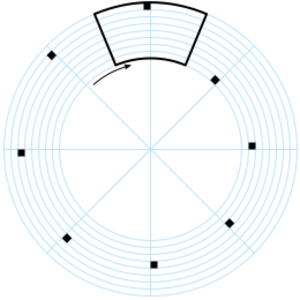Nipkow disk facts for kids
A Nipkow disk (also called a scanning disk) was a clever device invented by Paul Gottlieb Nipkow in Berlin in 1884. It was a key part of early mechanical television systems in the 1920s and 1930s. Think of it as a spinning wheel with holes that helped "see" and "show" pictures, making the first TVs possible!
Contents
How the Nipkow Disk Works
The Nipkow disk is a round plate made of metal, plastic, or even cardboard. It has many small, equally spaced holes drilled into it. These holes are arranged in a special spiral pattern, starting from the outside edge and curving towards the center.
When the disk spins, each hole traces a circular path. Imagine looking through a tiny window that moves in a circle. As the disk spins very fast, these holes quickly scan across an image, one line at a time.
Here's how it helped with early TV:
- Scanning the image: Light from a scene would shine through the spinning holes onto a special light sensor. Each hole would let through a tiny "slice" of the image. The sensor would then turn this light into an electrical signal.
- Showing the image: To see the picture, another Nipkow disk was used. This second disk spun at the exact same speed as the first one. An adjustable light source, controlled by the electrical signal, would shine through its holes. As the holes spun, they would recreate the image, line by line. If the disk spun fast enough, your eyes would see a complete, moving picture!
Why the Nipkow Disk Was Good
The Nipkow disk had some cool advantages for its time:
- Simple sensor: It only needed one simple light sensor, like a photocell, to pick up the light. This made the early TV cameras much easier to build.
- Easy to build: Both the camera (for scanning) and the TV (for showing) parts were quite similar. This made them simpler to put together.
- Paved the way for TV: These simple designs helped inventors like John Logie Baird create the very first mechanical televisions. It also allowed early "TV enthusiasts" to experiment with broadcasting pictures over radio waves in the 1920s.
Why the Nipkow Disk Wasn't Perfect
Even though it was groundbreaking, the Nipkow disk had some big drawbacks:
- Low picture quality: The number of holes on a disk was limited, usually from 30 to 100. This meant the pictures had very few lines, making them look blurry or blocky.
- Curved lines: The holes traced curved paths, not straight lines. This made the images look a bit distorted. To fix this, the disks would need to be huge, which wasn't practical.
- Tiny pictures: The images produced were usually very small, sometimes only the size of a postage stamp!
- Big and noisy: Early TV sets using Nipkow disks were large, heavy, and made a lot of noise. The pictures also flickered a lot.
- Needed bright lights: To get enough light for the camera, the subject being filmed needed to be lit very, very brightly.
Later, electronic ways of scanning images, like the Iconoscope, became much better. These new methods could gather a lot more light and create much clearer, bigger pictures.
Modern Uses
While the Nipkow disk isn't used for televisions anymore, its clever design still helps us today! One type of powerful optical microscope, called a confocal microscope, uses a Nipkow disk. This allows scientists to see very tiny details in cells and other materials.


